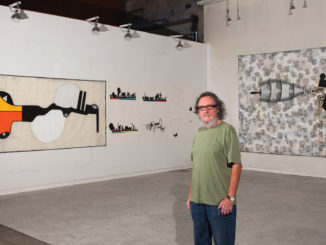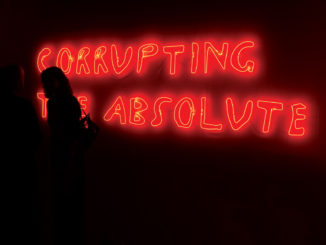 Collector’s can’t buy it, it is all for the public. The gigantic, eye-catching maze of artwork throughout Wynwood keeps expanding – on view are more than two dozen of works by graffiti artists from all over the world, big murals painted directly onto the warehouse buildings.
Collector’s can’t buy it, it is all for the public. The gigantic, eye-catching maze of artwork throughout Wynwood keeps expanding – on view are more than two dozen of works by graffiti artists from all over the world, big murals painted directly onto the warehouse buildings.
The largest show of such pieces mounted in one location, the Walls add a sense of permanence to the art scene in the district – their raw, bold, and unexpected symbolism all seem to scream to the rest of the city that culture is here to stay.
Spearheading the project is real estate developer and art aficionado, Tony Goldman. Known for his involvement in Downtown Philadelphia and New York’s Soho’s revival, Goldman has been investing in Miami – which he calls the “American Riviera” – for the past three decades. In 2005, he bought his first properties in Wynwood, already envisioning a total transformation of the neighborhood.
Uncommercial art as a way of social and political expression would be the renewal’s catalyst, he planned, and its medium simple and straightforward as Wynwood itself.
“Historically, walls have been known to confine peoples and cultures,” Goldman said. “The Wynwood Walls are meant not to limit, but to reassert connections. We want to expand the art that is already an essential element of Miami by having Wynwood showcase it to the world.”
Goldman’s idea of artists conscientiously transforming white space into “aesthetic gold” finally materialized in 2009, when the Wynwood Walls debuted during Art Basel with twelve murals, including elaborate art by artists such as Aiko, Stelios Faitakis, Barry McGee, Ara Peterson, Clare Rojas and Kenny Scharf. The original works also featured graffiti by Futura, one of the originators of urban art “Wild Style” in the early 1980’s “tagging” composed of complicated interlocking letters, arrows, and embellishment which was formerly illegally spray painted on walls, trains, subways and other public surfaces.
An international project aimed at creating dialogue within the community and between local and international artists, the Walls’ all-inclusive roster also features Shepard Fairey, the controversial American illustrator and street artist who became widely known in the 2008 presidential election with his Barack Obama Hope poster.
Graffiti artists are known as “writers” and their writing is commonly referred to as “tagging” or “bombing”. Their imposing on public space is often interpreted as a way of challenging the idea of what type of artists can represent themselves publicly, resistance and rebellion, or the plain desire to share their art with their community. For this project, the artists donate their time to work on the Walls and, in exchange, are provided with lodging during their stay.
Gaia, a young artist from New York said he believes the Walls gives graffiti art a unique support and an incredible platform for the recognition it deserves for tapping directly into a community’s desire to make its own uncensored voice heard, as a result pushing artists to express their own vision. “The most appealing aspect of street art for me isn’t style or form, but its simple execution, regardless of whether a piece actually looks good or not,” he said. “The very fact that anyone could ostensibly grab a can of spray paint, wheat-paste, or any tool for that matter and speak to the world without any hindrance is something beautiful and politically important. There is no curatorial team, council board, gallery director or community association as a filter for expressions. The only obstacle between the artist and their chosen surface or space is the law. If one is willing to take the risk, then nothing can stop its application, and the only boundaries are respect for the environment.”
For this year’s Art Basel Miami Beach Goldman’s urban art park is growing to twenty-eight pieces, incorporating more “graffiti with an accent” with artists still virtually unknown to the U.S. market, such as Ukrainian Interesni Kazki. World-renowned Brazilian graffiti-art twins Os Gemeos – known for revolutionizing their home country’s street art – also sprayed paint their mark in town by bringing several artist friends from their home country to collaborate on their mural, which covers the building at the corner of NW 2nd Avenue and NW 26th Street.
Concentrated in the area between 2nd and 5th avenues and NW 22nd and 28th streets, the project expansion debuts on Tuesday, November 29th. A special reception takes place at Goldman’s new Shop the Walls, an indoor space located at 2550 NW 2nd Avenue. The Wynwood Walls gallery pop-up space offers unique art pieces for sale, including the Wynwood Walls book featuring photography by Martha Cooper and a series of limited edition t-shirts designed by the artists.
Meanwhile, Miami art lovers are already taking advantage of the Walls’ transformative presence. The area has become known as a great location for picture-taking, bike rides, and even wedding proposals.
“As other areas of the city get more and more touristy, we locals need alternative spaces,” said Matteo Bianchi, a real estate investor and Miami Beach resident.
Once known as a warehouse district, a walk down Wynwood now presents scenes of commerce and community that are dynamic and downright artsy. The neighborhood is now home to over fifty galleries, four museums, numerous art complexes and artist studios, and an increasing array of satellite fairs associated with Art Basel Miami Beach. The Walls, along with Wynwood’s monthly Saturday Art Walks manifest this in its most concentrated and current state.
Lauren Wagner, director of exhibits at the Bakehouse Arts Complex in Wynwood, said the oversized art fits like a glove with the neighborhood’s urban art tradition, making it even more accessible. “The Walls are helping street art becoming more acceptable and approachable from a fine art perspective.” she said, “They also have beautified the area, so many corners now a surprise, real artistic feasts.”
They have also added Miami to the international street art map. To complement what director of the Lost Angeles Contemporary Art Museum Jeffrey Deitch has called “a museum of the streets,” this year Goldman also makes public sixteen additions to the Wynwood doors, a satellite project comprised of 176 feet of rolling storefront steel doors adjacent to the Walls. The Doors debuted in 2010, with the work of artists Phase II and Coco 144, early writers of the New York subway system. The Walls Outside the Wynwood Walls throughout Wynwood are also being unveiled, with an eclectic mix of art created by Friends With You, Avaf, and Nunca.
Goldman says the Walls are a never-ending, evolving project. He hopes to develop Wynwood into the mural art capital of the world. Among other plans for expansion, he highlighted that a Wynwood Walls phone app is under development, to work in conjunction with a bar code on each of the murals.
“The mixture of graffiti artists and studio artists conquering walls in the streets provides viewers with an artistic line up that is rare to find in any gallery,” explained Davide and Raoul Perre, twin brothers from Germany known as How & Nosm, whose Wynwood wall reflects on the destruction of the environment.
“The conditions under which this type of art is created, especially when done illegally, pushes the boundaries of any artist. To create art under pressure while staying focused enough to deliver a unique piece of art is an interesting challenge.”
“Wynwood itself isn’t a tourist-heavy area, so the neighborhood suffers not only visibly but also financially,” said the artists. “Where artists migrate to live or work, great things eventually take place and that is what usually attracts people who would not care much about these neighborhoods in the first place. Automatically, there is a cash flow to these areas, which benefits local businesses. Investors come with sparked interests which others in turn catch on to.”
Goldman, who calls himself an artistic business man, has also been helping turn Wynwood around by adding another essential ingredient to create a more pedestrian-friendly environment: accessible alfresco dining. In 2010 he opened this artful restaurant, Wynwood Kitchen & Bar. Featuring bold black and red collage murals by Shepard Fairey and 20-foot abstract paintings by Christian Awe, the venue’s deco follows suit to the street art concept it is surrounded by – it is strategically located in the center of the Walls park. His nearby Joey’s has been already rated one of the best restaurants in town.
Goldman explains that the Walls also serve and educational goal – to expose locals and visitors to other cultures and realities. But there are some ground rules. Artists are encouraged to “think outside the box,” and have free reign on subject matter, as long as allusion to racism and other over-the-top polemical topics are avoided.
“Ultimately, we are looking for what this artists on the streets see when they visit to transcend into their imagery and symbolism,” he said. “Their stories, different visions and perspectives are to serve a lively backdrop to a flourishing, dynamic atmosphere, and Miami is their perfect unconventional inspiration.”



Be the first to comment